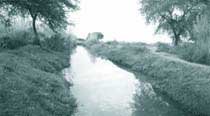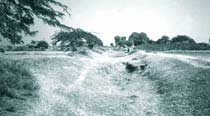| |
NETWORKING |
|
| Strengthening the water bond Continuing wisdom Meet some of them... Their impressions Water warrior speak out |
||
FUNDING AGENCY |
||
| Danida watershed development programme (DANWADEP )
India |
||
INITIATIVE |
||
| Little Wonders |
||
REMEMBERING |
||
| The magician without a wand |
||
TRADITION |
||
| Legacies of the past Venishing Madakasr |
||
RESEARCH PAPER |
||
| Cholistan's story |
||
SEE IT TO BELIEVE IT |
||

Vol. 3
No.
2
April 2001
![]()
Legacies of the past
Dholpur, the name brings to mind the rich redstone facades of Red Fort and Rashtrapati Bhawan. The eastern most district of Rajasthan on the banks on river Chambal famous for its red sandstone has had a rich tradition of rainwater harvesting since ages. Out of the 25 rainwater harvesting structures built here 13 were constructed before Independence, with a few having reference to the Moghul period as well. Interestingly, many of these structures continue to serve as source of irrigation till this day. But due to erratic rainfall, bad maintenance and absence of proper water distribution the structures are unable to live up to their potential resulting in conflicts and wastage.
 |
 |
| Nibi canal, when water flowed | The dry canal at Nurpura as they stand today |
Till Independence, Dholpur had been a princely state under the Jat rulers. A number of rainwater harvesting structures were built during their reign with particular mention to maharaja Uday Bhan Singh. He had a passion for constructing rainwater harvesting tanks. These were made by constructing roads in between mountains thus serving dual purpose of road as well as embankment for the reservoir.
The most notable structures built before Independence are Urmilasagar and Ramsagar. Besides these two there are numerous small structures built in between Dholpur and Bari ( about 35 km west of Dholpur town). These tanks have a rich history associated to them. While Chitariyataal was built by the Moghul Emperor Babur, Talabshahi, another water harvesting structure was build by Jahangir. Machkund which has a reference in Mahabharata was also the place where Guru Gobind Singh had stayed while returning from Gwalior in 1662. The Nibi canal system that originates at the Urmilasagar (located 22 km ) was built to get water for the Dholpur palace gardens and as a source of water for the wild animals at Ban Vihar reserve forest. The 17 km long canal with 20 km of minors irrigates about 1214 ha of land. Another tank, Ramsagar (located 40 km from Dholpur near Bari) with 11 km long main canal and 39 km of minors irrigates about 2,143 ha of land. Presently its 174 sq km catchment is largely the Ramsagar Wild life sanctuary. It was built primarily to get water to Bari and adjoining villages. In those days there was a definite system of water management with people paying taxes on the basis of production and area irrigated. There was also proper allocation of time and quantity of water supply to different villages for efficient sharing of water. The taxes collected were used for repair and maintenance of the canals every year.
As India got its Independence and the water rights shifted from the hands of the people to the government, there started the process of negligence and misuse. Today the canal lies in a deplorable condition, with depressions, breaches and leaks (a foot of water is lost in seepage and leaks in the Urmila sagar). Due to fund freezing by the Rajasthan government in the recent years, the department of irrigation does not have the funds for even minor repairs to the tune of 1 lakh for the Nibi canal. The World Bank has prepared a project for lining and resectioning of the main canals of Dholpur namely, Nibi canal, Ramsagar main canal and minors and Parvati main canal under the Rajasthan Water Resources and Canal Project (RWRCP) at a cost of Rs 27 crores. But the work is expected to start after April 2002 by the department of irrigation under Phase 2 of the project. Meanwhile the flow rate in the canal has reduced to 38% of the actual capacity. The department estimates that about Rs 10 – 12 lakh would be required to repair the canal to bring its normal flow and subsequently Rs 1.5 lakh every year for annual repairs. The people however tell a different story. According to them, the department gobbles up the funds and does superficial repairs. The laxities on the part of the authorities coupled with decreasing and erratic rainfall patterns have aggravated the situation. The water sharing has no rules; here might is right. Frequently the villagers upstream hold water using earthen bunds leading to conflicts and fights. The incident of firing between two villages led to complete closure of the dam gates by order from the collector. The resulting water shortage has lead to crop shifting. Gram, barley, mustard are being preferred as compared to crops requiring more water. The absence of canals has shot up the farmers' investments to Rs 1250 per bigha (at the rate Rs 50 an hour for five hours for five irrigation of wheat) on rented engine and Rs 450 on own engine (at the rate 1 litre of diesel consumed every hour) as compared to only Rs 25 flat per bigha as water charges. Due to bedrock at 50 feet depth, bore -wells have also failed in many places. In the absence of proper irrigation the yield has decreased thus not only decreasing the farmers income but also affecting his annualbudget.
These traditional water harvesting systems are the lifeline of the farmers in Dholpur. The water canals not only provide water for irrigation but are extemely rich in terms of fisheries too. The department of fisheries estimates about Rs 2 lakh of fish would be available presently in the reservoirs. The tank systems recharge the aquifers, wells and other small tanks that serve as livelihood for many through Trapa (water nuts) cultivation. These tanks that are the source of drinking water for the animals in the summers are also the habitat of a number of avian species along with migratory birds. A stream by the name Medki nala that originates from the seepage of the Urmilasagar provides water to about 21 villages on its bank before ending at river Parvati. The list of benefits can go on. But today like the sleeping legacies of the Dholpur state, they silently wither away as remnants of a bygone era.
For further information:Saumik Banerjee
E-302, Mayfair Apartments
96,IP Extn.
New Delhi-110092
Vanishing Madakas
It is an established fact that there is no water shortage but only gross mismanagement
of the resource. This is once again demonstrated by the plight of the madaka, traditional
water harvesting structures in coastal districts of Dakshina Kannadain Karnataka and
Kasaragod in Kerala. Madakas are valley like traditional structures created between
hillocks to which a bund is built with locally available laterite stone and soil requiring
very less labour. These were placed in strategic locations so as to collect large
quantities of rainwater from the adjoining areas. Realising their importance, Samriddi
Charitable Trust, Kasaragod
is generating awareness about these structures and has also rebuilt a few.
 |
Madaka at Jokulakatte of Meenja Panchayat rebuilt by 'Samriddi' |
These areas, on an average, receive annual rainfall of 3,500 mm. During the monsoons
these districts suffer from floods and in summers (from February to June) there is acute
scarcity of water both for irrigation and drinking. The forest cover in the districts have
been reduced remarkably due to the encroachment of plantation crops on forests,
urbanisation and continuous demand on the land for infrastructural needs in the last 50
years. Besides madakas, these districts also have a tradition of tanks and majir pallas
(natural depression on the top of the hills to collect rain) for rainwater collection. But
today most of them are filled with silt failing to contribute much for rainwater
infiltration. The objective of the madakas was not only to facilitate infiltration but
also to check soil erosion. This method was quite effective in recharging the groundwater
aquifers thereby increasing the availability of drinking water in the open wells in the
region. With
growing pressure on land the government with its new policy allotted these areas on
request for agricultural or infrastructural uses. Now with the madakas fast disappearing
there is enormous pressure on the groundwater. With groundwater depletion and soil erosion
on the rise, the district is left to struggle with alternating droughts and floods.
Dr. D C Chowta
Samriddi Charitable Trust
Meenja Panchayat, P. O. Meeyapadavu
Kasaragod- 671323, Kerala
Ph: 0499- 850251